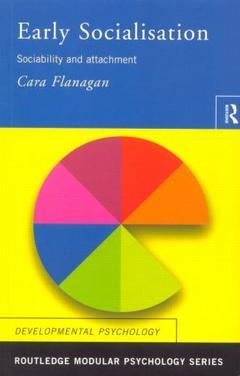List of illustrations -- Acknowledgements -- 1 Introduction -- Some early views of childhood -- The beginnings of childhood -- This century -- The maternal deprivation hypothesis -- Evaluation -- Imprinting and bonding -- Imprinting, bonding and attachment -- Bowlby's theory of attachment -- Sociability -- Cross-cultural research -- Summary -- 2 Sociability -- Introduction -- Innate social abilities -- Specific behaviours -- Emotional expression -- Emotional sensitivity -- Learned social abilities -- Nature and nurture -- An interest in faces -- More and more smiles -- Reciprocal relationships -- Ethical and methodological issues -- Individual differences -- Innate factors -- The influence of others -- Summary -- 3 Imprinting and bonding -- Introduction -- Imprinting -- Konrad Lorenz and greylag geese -- Critical period hypothesis -- Sensitive period -- Supra-individual -- Consequences of imprinting -- Evaluation -- Bonding in non-human animals -- Wire mothers -- Experimental variations -- Conclusions -- Evaluation of non-human research -- Bonding in humans -- Skin-to-skin contact -- Evaluation -- Ethical and practical concerns -- What bonding research means for attachment -- Summary -- 4 The attachment process -- Introduction -- What is attachment? -- The development of attachment behaviour -- 1 The asocial stage -- 2 Indiscriminate attachments -- 3 Specific attachments -- 4 Multiple attachments -- Understanding why these changes take place -- Evaluation -- Individual differences in attachment -- Measuring attachment -- What the Strange Situation measures -- Types of attachment -- Stability of attachment -- Evaluation -- The value of a secure attachment -- Short-term effects: benefits of secure attachment -- Long-term effects: emotional development and relationships -- Long-term effects: parenting -- Long-term effects: personality development -- Long-term effects: self-esteem -- Long-term effects: cognitive development -- Evaluation -- Monotropy versus multiple attachments -- Monotropy -- The case for multiple attachments -- Evaluation -- Summary -- 5 Privation -- Introduction -- Children reared in isolation -- The Koluchova twins (PM and JM) -- Genie -- Evaluation -- Institutionalisation -- Skeels' study -- Tizard's study -- Evaluation of Tizard's study -- Other studies -- Romanian orphans -- Conclusions -- Reactive attachment disorder -- The effects of privation -- Some conclusions -- Privation or deprivation? -- A sensitive period? -- Individual differences in coping -- Methodology -- What does it matter? -- Summary -- 6 Separation -- Introduction -- Responses to separation -- Separation anxiety -- Criticisms of the POD model -- Hospitalisation -- Hospitals and later maladjustment -- Evaluation -- Day care -- Day care in a nursery -- Day care with a childminder -- Attachment to day-care provider -- Evaluation -- Divorce -- Parental discord -- Explanations -- Final evaluation of separation experiences -- Summary -- 7 Social and cultural variations -- Introduction -- What is 'cultural variation'? -- Cultural variations in attachment -- Cultural similarities -- The Strange Situation -- The Strange Situation as an imposed etic -- One or many attachments? -- Are there any differences? -- Attachment and economics -- Conclusions -- Cultural variations in childrearing -- Studies of Western childrearing styles -- Evaluation -- Social class (sub-cultural) differences -- Cross-cultural studies -- Conclusion -- Summary -- 8 Theories of attachment -- Introduction -- What is a theory of attachment? -- Attachment theory before Bowlby -- Freudian theory -- Behaviourist theory -- Evaluation of Freudian and behaviourist approaches -- The ethological approach -- Bowlby's theory -- The influence of psychoanalysis: maternal deprivation -- The influence of ethology: attachment theory -- A critical or sensitive period -- Is attachment innate? -- Monotropy -- The internal working model -- Caregiver sensitivity hypothesis -- A secure base -- Attachment theory -- Evaluation of Bowlby's theory -- Rutter's commentary: maternal deprivation reassessed -- Other criticisms of Bowlby's theory -- Final analysis -- Summary -- 9 Enrichment -- Introduction -- What is enrichment? -- Cognitive development -- Perceptual development -- The effect of institutionalisation -- Other studies of visual deprivation -- Conclusion -- Language development -- Linguistic enrichment -- Criticisms of verbal deprivation theory -- Reading -- Speech -- Development of intelligence -- Hothousing -- Preschool enrichment programmes -- Nutritional enrichment -- Intelligence enrichment programmes: conclusions -- Social and emotional development -- Popularity -- Attachment -- Conclusions -- Summary -- 10 Study aids -- Practice essays -- Key research summaries -- Bowlby (1946) Forty-four juvenile thieves -- Schaffer and Emerson (1964) The development of social attachments in infancy -- Fox (1977) Attachment of kibbutz infants to mother and metapelet -- Glossary -- References -- Index.




